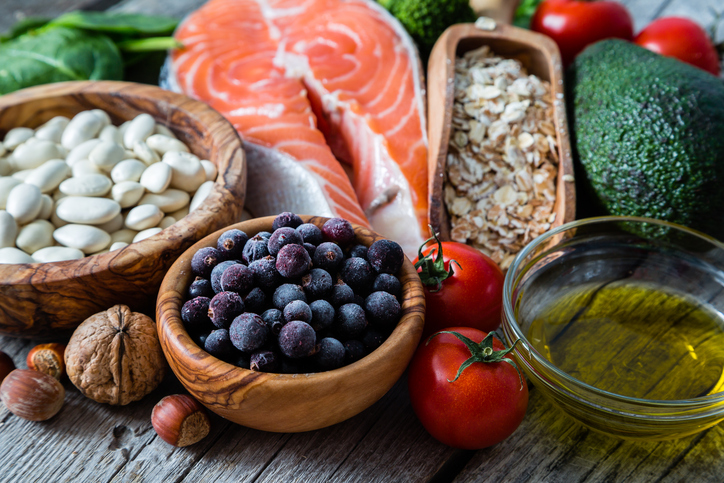Much of good health is dependent on good nutrition. The USDA publishes updated dietary guidelines every 5 years based on extensive research to help you improve your nutrition. These guidelines set the standard for healthy eating in the United States. Making sense of the guidelines can be tough, but we’re here to explain them to you!
What are the key takeaways?
- Healthy eating is a lifetime behavior. Foods and beverages should be consumed in a manner that is beneficial to your health and maintaining a healthy weight.
- There is no “one size fits all” model of healthy eating; everyone is different, but there are certain general rules to follow to create your healthy eating pattern.
What is a “healthy eating pattern”?
A healthy eating pattern focuses on variety, nutrient-density and amounts of foods and beverages. It consists of eating foods high in vitamins and minerals from all food groups.
What food groups are emphasized by the guidelines?
- Fruits – This includes whole fruits (which can be fresh, frozen, canned or dried) and 100 percent fruit juice.
- Be sure that at least half of your fruit intake consists of whole fruits.
- Vegetables – Leafy greens; red, orange and other colors; legumes like beans and peas; and starches all make up this food group.
- Aim to eat a variety of vegetables from each of the subgroups of vegetables. Fresh, frozen and canned are all good options.
- Protein – Foods such as seafood, lean meats, poultry, eggs, legumes, nuts, seeds, and soy products are included in this group.
- Satisfy this food group while aiming to get your protein from a variety of sources.
- Dairy – This food group includes milk, yogurt, cheese and fortified soy products.
- Opt for low-fat or fat-free dairy products.
- Grains – This is an important food group when striving to eat healthy, specifically whole grains. When grains are “refined” it strips the nutritional value of the grain kernel. While some refined grains products are enriched to compensate, they also add excess sugar, saturated fat and sodium.
- Strive to make half your grains whole.
- Oils – This food group is an excellent source of healthy fats, essential fatty acids and Vitamin E. Focus on plant based oils such as canola, olive, peanut and sunflower. Coconut and palm oils are not included in this category since they are high in saturated fat.
- Use oils when cooking as often as possible in lieu of solid fats like butter, margarine and shortening.
What foods should be limited?
- Saturated fat – The primary sources of saturated fats are high fat meats and dairy products, processed snack foods and baked goods.
- Limit your saturated fat intake to less than 10 percent of your daily calories.
- Added sugars – Foods and beverages that use sugar to enhance flavor are the main source of added sugar. Foods that have natural sugar such as fruit and dairy are not considered added sugars and do not count toward your sugar intake.
- Limit your added sugar intake to no more than 10 percent of your daily calories.
- Sodium – This favor enhancer and preservative is found in a multitude of foods as well as often manually added to meals for taste.
- Limit your sodium intake to 2,300 mg per day. If you are hypertensive or pre-hypertensive, you should limit to 1,500 mg per day.
What other things should be considered within the guidelines?
- Dietary cholesterol is not the villain it once was. While high cholesterol is unhealthy, avoiding foods that have cholesterol will not help to lower your cholesterol. Our bodies produce cholesterol naturally. Some people naturally produce more cholesterol than others. The best way to lower your blood cholesterol is through a diet low in saturated and trans fat, consisting of predominantly fruits and vegetables, fiber-rich foods like whole grains, as well as through physical activity and avoiding the use of tobacco products.
- Make healthy decisions when it comes to choosing what to drink.
- Choose calorie free beverages or drink options that add nutrients to your diet such as 100 percent fruit juice and low-fat dairy.
- Consume alcohol in moderation; women should not exceed one drink per day, while men should not exceed two drinks per day.
- If you opt for coffee or tea, be sure to account for the sugar and cream added when considering your healthy eating pattern.
- There are some types of fats that are important for a healthy eating pattern. These include: monounsaturated, polyunsaturated and omega 3 fatty acids.
For Health Advocate Members
If you’re a Health Advocate member with access to the wellness coaching component of our Wellness Program, connect with a coach today for more information on healthy eating and the dietary guidelines.



